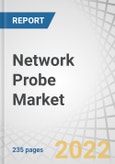The network probe market is projected to grow from USD 549 million in 2022 to USD 908 million by 2027, at a CAGR of 10.6% during the forecast period. The need for smooth network transitions to avoid downtime and agile networking operations under monitored environments is expected to drive the adoption of network probe solutions.
By deployment mode, cloud-based solution to register higher CAGR during forecast period
Cloud-based solution is not only enabling organizations to manage their costs but also helping them in improving business agility. There has been explosive growth in cloud-based services, and the dependency of SMEs on the cloud is relatively higher. With the cloud-based deployment of network probe solutions, small enterprises can collect and analyze data, thus improving their customer services. Cloud-based deployment is growing at a higher rate than that on-premises deployment, as cloud-based network monitoring solutions provide real-time data filtering and storage over the cloud rather than physical devices. Moreover, the cloud segment is expected to grow as cloud technology would enable firewall solutions to cost-effectively identify threats to sensitive data.
By organization size, large enterprises to account for largest market share during forecast period
Network probe enables large enterprises to solve their data and network management problems in a better manner. Enterprises, service providers, and data center operators have started to deploy network probe tools on a large scale to manage and analyze network traffic and protect it from security attacks. Network probe solutions can enable large organizations to manage the entire IT infrastructure environment with real-time application monitoring, monitor network traffic, and find sources causing networks to slow down in seconds.
Among regions, market in Asia Pacific to register highest CAGR during forecast period
The growth of the network probe market in the Asia Pacific is highly driven by technological advancements across the region. The existence of a large population and developing infrastructure and technology are major factors contributing to the growth of the network probe market in the Asia Pacific. It is expected to be the fastest-growing global network probe market, owing to the expansion of the customer base for network monitoring software and the emerging trend of network probe hybrid deployment. APAC is projected to witness enhanced growth opportunities during the forecast period. Countries in APAC are contributing toward the market's growth, owing to the rapid adoption of various network probe solutions by enterprises in the region.
Breakdown of primaries
In-depth interviews were conducted with Chief Executive Officers (CEOs), innovation and technology directors, system integrators, and executives from various key organizations operating in the network probe market.
- By Company Type: Tier I: 35%, Tier II: 45%, and Tier III: 20%
- By Designation: C-Level Executives: 35%, Directors: 25%, and others: 40%
- By Region: North America: 45%, Europe: 20%, Asia Pacific: 30%, RoW: 5%
The report includes the study of key players offering network probe solutions and services. It profiles major vendors in the network probe market. The major vendors in the network probe market include SolarWinds (US), NETSCOUT (US), Broadcom (US), IBM (US), Cisco (US), Nokia (Finland), NEC (Japan), AppNeta (US), Catchpoint (US), Accedian (Canada), Paessler (Germany), ManageEngine (US), Progress (US), Nagios (US), Dynatrace (US), HelpSystems (US), Riverbed (US), ExtraHop (US), Micro Focus (UK), Cubro (Austria), Plixer (US), Kentik (US), ObjectPlanet (Norway), Flowmon (Czech Republic), Qosmos (France), Radcom (Israel), Firstwave (Australia), and 3Columns (Australia).
Research Coverage
The market study covers the network probe market across segments. It aims at estimating the market size and the growth potential of this market across different segments, such as by component, organization size, deployment mode, end users and region. It includes an in-depth competitive analysis of the key players in the market, along with their company profiles, key observations related to product and business offerings, recent developments, and key market strategies.
Key Benefits of Buying the Report
The report would provide the market leaders/new entrants in this market with information on the closest approximations of the revenue numbers for the overall network probe market and its subsegments. It would help stakeholders understand the competitive landscape and gain more insights better to position their business and plan suitable go-to-market strategies. It also helps stakeholders understand the pulse of the market and provides them with information on key market drivers, restraints, challenges, and opportunities.
Table of Contents
Companies Mentioned
- Accedian
- Appneta
- Broadcom
- Catchpoint
- Cisco
- Cubro
- Dynatrace
- Extrahop
- Flowmon
- Helpsystems
- Ibm
- Kentik
- Manageengine
- Micro FocUS
- Nagios
- Nec
- Netscout
- Nokia
- Objectplanet
- Paessler
- Plixer
- Progress
- Qosmos
- Riverbed
- Solarwinds
Methodology

LOADING...
Table Information
| Report Attribute | Details |
|---|---|
| No. of Pages | 235 |
| Published | November 2022 |
| Forecast Period | 2022 - 2027 |
| Estimated Market Value ( USD | $ 549 Million |
| Forecasted Market Value ( USD | $ 908 Million |
| Compound Annual Growth Rate | 10.6% |
| Regions Covered | Global |
| No. of Companies Mentioned | 25 |









